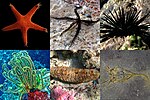Articulata are a subclass or superorder within the class Crinoidea, including all living crinoid species. They are commonly known as sea lilies (stalked...
6 KB (653 words) - 17:34, 1 July 2024
species), Holothuroidea (sea cucumbers, with about 1,430 species), and Crinoidea (feather stars and sea lilies, with around 580 species). The extant classes...
110 KB (11,057 words) - 00:20, 5 January 2025
culmination of his work was the two-volume "Monograph of the North American Crinoidea Camerata", coauthored with Springer and published posthumously in 1897...
9 KB (1,115 words) - 18:13, 11 February 2024
(stalked jellyfish) Polypodiozoa (marine parasites) Eucycliophora Dicyemida Crinoidea (sea lilies and feather stars) Asteroidea (star fish) Ophiuroidea (brittle...
8 KB (503 words) - 23:52, 29 December 2024
"Ausichicrinites zelenskyyi gen. et sp. nov., a first nearly complete feather star (Crinoidea) from the Upper Jurassic of Africa". Royal Society Open Science. 9 (7):...
5 KB (381 words) - 02:39, 10 November 2023
Camerata (crinoid) (redirect from Camerata (Crinoidea))
"Phylogeny and morphologic evolution of the Ordovician Camerata (Class Crinoidea, Phylum Echinodermata)". Journal of Paleontology. 91 (4): 815–828. doi:10...
5 KB (321 words) - 19:41, 18 November 2024
Nusplingen Limestone (section Crinoidea)
The Nusplingen Limestone (German: Nusplingen Plattenkalk) is a geological formation in Baden-Württemberg, Germany. It preserves fossils dating to the Kimmeridgian...
27 KB (1,231 words) - 04:52, 19 November 2024
Domenicoa, F.; S. Giacobbea; P. Rinellib (2009). "The genus Antedon (Crinoidea, Echinodermata) in the Strait of Messina and the nearby Tyrrhenian Sea...
3 KB (231 words) - 21:38, 22 November 2024
Promachocrinus fragarius (category Crinoidea stubs)
feather star species complex Promachocrinus 'kerguelensis' (Echinodermata: Crinoidea)". Invertebrate Systematics. 37 (7): 498–527. doi:10.1071/IS22057. ISSN 1447-2600...
3 KB (304 words) - 17:55, 7 December 2023
Pitkin Formation (section Crinoidea, Sea Lilies)
The Pitkin Formation, or Pitkin Limestone, is a fossiliferous geologic formation in northern Arkansas that dates to the Chesterian Series of the late Mississippian...
20 KB (1,286 words) - 08:32, 18 November 2024
feather star species complex Promachocrinus 'kerguelensis' (Echinodermata: Crinoidea)". Invertebrate Systematics. 37 (7): 498–527. doi:10.1071/IS22057. ISSN 1447-2600...
3 KB (293 words) - 06:41, 14 February 2024
division of the Crinoidea (phylum Echinodermata). Journal of Paleontology 72 (3): 499–510. Ausich, W. I. 1998b. Origin of the Crinoidea. In Echinoderms:...
3 KB (334 words) - 19:30, 22 February 2024
List of echinoderm orders (section Class Crinoidea)
This List of echinoderm orders concerns the various classes and orders into which taxonomists categorize the roughly 7000 extant species as well as the...
10 KB (470 words) - 20:31, 9 December 2024
stars, can detach limbs for self-defense and then regenerate them. The Crinoidea, sea fans, can go from stiff to limp depending on the current for optimal...
60 KB (6,701 words) - 08:45, 20 December 2024
Guillecrinidae is a small family of echinoderms in the class Crinoidea, and contains the following genera and species below. Guillecrinus Roux, 1985 Guillecrinus...
1 KB (58 words) - 18:46, 16 October 2021
The largest prehistoric animals include both vertebrate and invertebrate species. Many of them are described below, along with their typical range of size...
391 KB (40,792 words) - 09:24, 25 December 2024
stars (Ophiuroidea), sea cucumbers (Holothuroidea) and feather stars (Crinoidea). The largest animal phylum is also included within invertebrates: the...
45 KB (4,979 words) - 17:17, 31 December 2024
"Ausichicrinites zelenskyyi gen. et sp. nov., a first nearly complete feather star (Crinoidea) from the Upper Jurassic of Africa". Royal Society Open Science. 9 (7):...
254 KB (19,655 words) - 02:41, 5 January 2025
The marine waters of the Houtman Abrolhos, an island chain off the coast of Western Australia, has been recorded as containing 172 species of echinoderm...
8 KB (577 words) - 15:23, 18 January 2023
Saubach Formation (section Crinoidea)
The Saubach Formation is a geological formation in Austria and Germany, dating to about 180–174 million years ago. It was described originally as Saubachschichten...
21 KB (924 words) - 16:26, 6 January 2024
and 1967. In Venezuela are five classes representatives living today: Crinoidea, Asteroidea, Ophiuroidea, Echinoidea and Holothuroidea. In this list are...
68 KB (3,492 words) - 11:57, 10 April 2023
stalked and sedentary echinoderms. The main class of Pelmatozoa were the Crinoidea which includes sea lily and feather star. Pelmetazoa is no longer a classification...
16 KB (1,621 words) - 23:14, 8 November 2024
the Hunterian Museum in Glasgow. Scottish Carboniferous Crinoidea British Carboniferous Crinoidea Kammer, Thomas W.; Ausich, William I. (June 2007). "Stratigraphical...
3 KB (309 words) - 13:45, 28 December 2023
measure up to 1 m (3.3 ft) across and weigh 5.1 kg (11 lb). Crinoids (Crinoidea) The largest species of crinoid is the unstalked feather-star Heliometra...
169 KB (16,662 words) - 19:57, 19 December 2024
"Copernicrinus zamori gen. et sp. nov., the oldest thiolliericrinid crinoid (Crinoidea, Echinodermata) from the Bajocian strata of northwestern Algeria, Africa"...
390 KB (35,682 words) - 20:14, 4 January 2025
Onychocrinus (category Crinoidea stubs)
1906. Discovery of the Disk of Onychocrinus, and Further Remarks on the Crinoidea Flexibilia. The Journal of Geology, Volume 14. A. S. Horowitz. 1956. Fauna...
2 KB (218 words) - 08:20, 18 November 2024
Comatulida (category Articulata (Crinoidea))
Treatise on Invertebrate Paleontology, Part T, Echinodermata 2 Revised, 1633 Crinoidea, vol. 3. University of Kansas Press, Lawrence, Kansas, pp. 70–146. Dorit...
9 KB (1,042 words) - 21:08, 26 August 2024
























